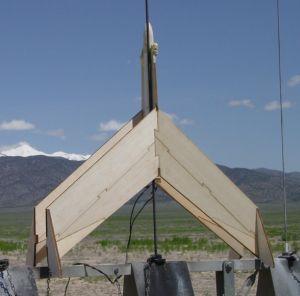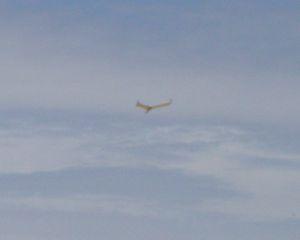Edmonds Aerospace Geminee Thunder
Edmonds Aerospace - Geminee Thunder {Kit}
Contributed by Frank G. Whitby
| Construction Rating: | starstarstarstarstar |
| Flight Rating: | starstarstarstarstar_border |
| Overall Rating: | starstarstarstarstar |
| Manufacturer: | Edmonds Aerospace |
Brief:
Geminee Thunder is an upscale version of the Edmonds Geminee twin glider.

Construction:
As with other Edmonds gliders, the kit comes complete with detailed
instructions and well designed, precision cut balsa parts ready to be
assembled. All of the parts were in perfect condition and high quality balsa
was used throughout.
The assembly was very simple. Rob Edmonds justifiably prides himself on producing kits comprising the minimum number of parts and requiring no re-fitting of pieces prior to assembly. All pieces were dry fit and then glued with very small amounts of 5-minute epoxy. The instructions suggested using wood glue, but I did not have any on hand. I used epoxy sparingly so as to prevent unnecessary addition of weight.
The motor mount and coupler that joins the two halves of the glider required some careful adjustment during assembly. Alignment of the fin tips was aided by laying out the pieces on wax paper for gluing. The instructions recommend balancing the gliders with clay, but I could not lay my hands on any. I used some lead shot and masking tape to weight the nose of each glider instead. I did not measure the final constructed weight of the gliders.
The construction can be accomplished in an hour or so, but I spread out the construction over a few days. Construction is well within the ability of novice builders and the gliders have a very nice, stout feel to them. The biggest problem I faced was transporting the gliders to the launch site without inadvertently sitting on them in the car or other rough handling.
Finishing:
I did not paint the glider.
Construction Rating: 5 out of 5

Flight:
The instructions suggest using a D12-3, so that is what I used. I made a small
thrust ring of masking tape and then taped the motor securely in place. The
glider boosted very nicely to 200 feet or so and separation was very near
apogee or just a bit past. The two gliders fell away from each other, began to
descend, turned gently away from each other and came back up wind in a
beautifully symmetric pair of spirals. The two gliders nearly met at the middle
of their long sloping turns and then touched down at almost exactly the same
moment about 100 feet apart traveling in opposite directions. The rear glider
snagged a 12 inch tall clump of weeds at the last moment, causing it to twist
as it hit the ground and caused the nose piece to break off. The front glider
landed gently with no damage.
Recovery:
The motor mount tube was badly scorched by the heat of the D motor. The tube is
crusty and slightly misshapen. I think I will have to replace it before the
next flight. The nose of the rear glider can be glued back on and should be
just fine. I think the noses of both gliders have slightly too much weight in
them, so I could probably achieve a slightly shallower and more stable glide
path if I removed a gram or so of nose weight from each glider.
Flight Rating: 4 out of 5
Summary:
Construction and flight of all Edmonds kits that I have built to date have been
very satisfying. The Geminee Thunder is simple to build and would be an
excellent choice for a beginner modeler wanting to show off with a beefy
glider. It looks to me like the gliders should be able to withstand boost on an
E impulse motor, so I plan to try this next. Despite the damage to the motor
mount from the engine, the design appears to be flawless.
Overall Rating: 5 out of 5
Other Reviews
- Edmonds Aerospace Geminee Thunder By Hank Helmen
Brief: The Edmonds Geminee Thunder is a twin glider with a single 24mm rear engine. The gliders are supposed to boost up on D12-3 and then separate using the ejection charge. Glider should then circle slowly back to earth! Construction: Included in the kit is one balsa nose cone, one balsa "plug" (to join the glider body tubes), two 25mm body tubes, four sheets of ...
 |
 |
Flights
 |
 |
H.W.H (March 11, 2006)
Sponsored Ads
 |
 |












H.W.H. (January 28, 2006)